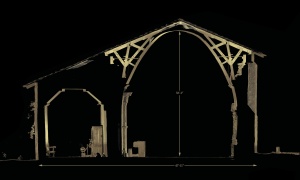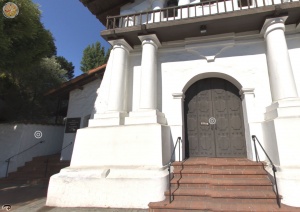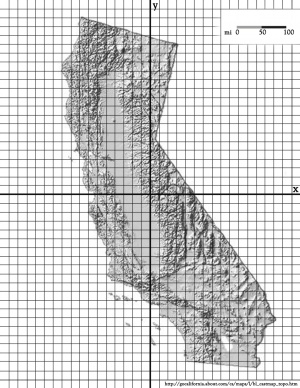El Camino Real Lesson Plans Go Live
May 20, 2014
With the generous support of IBM, CyArk is pleased to announce the completion of three lesson plans inspired by the El Camino Real de California digital preservation project. All three lesson plans are now available on CyArk’s website, and are also included on IBM’s online platform, Teachers TryScience.
CyArk worked to create these lesson plans in conjunction with Sonoma County teaching professionals from Technology High School and Crescent Montessori School . The teachers produced three exciting lessons plans that introduce students to 3D data and visualizations as they learn about California history. Many thanks to teachers Joe Immel, Matt Zwinge, Casey Welch, and Janet Chaterji, for their commitment, enthusiasm, and wonderful ideas!
To ensure that the lesson plans are available to a wide audience, CyArk engaged its network of global volunteers to assist in making these lesson plans and activities accessible to Spanish-speaking audiences. Our volunteers helped with lesson plan translation, worksheet conversion, summary statements, and reviewed the overall lesson plans. Many thanks to our volunteers: Angel Menargues, Camilo López Aguirre, Carolina Cortés Uzarska, Gustavo Coronado Chacón, Peter Monro, Ursicio Javier Martín Martino, and Valentina Tarantini, for generously donating their time and talent to enhance this project! Without their support, these lesson plans would be inaccessible to a large constituency of California elementary students.
The lessons cover a diverse range of topics:
1. Design and Conquer: Architecture of El Camino Real de California
In this lesson, students investigate the form and function of Spanish missions to answer the question: how did the Spanish utilize architecture to achieve their purpose in California? The Spanish Colonial style will be studied closely and researched for a better understanding of its influence on the structures we see around us today. Making use of site visits, virtual tours, 3D scan data, and 3D drawing and modeling programs (like Google SketchUp or MineCraft), students will have an opportunity to develop a mission site that is historically accurate in style, layout, and material.
2. La Próxima Parada: The Next Stop Along El Camino Real
This lesson encourages students to think about the strategy behind the locations where missions were built along El Camino Real, and the unique challenges encountered in establishing each mission. Students will measure distances between the mission sites and consider the obstacles and motivations present at the time to justify the location of each stop along El Camino Real. In analyzing the 3D content available and conducting independent research, students will propose the next location along El Camino Real, rationalizing their decision in front of a mock council. Students will take on historically relevant perspectives in defending their decisions, taking into consideration the social and political climate in the early to mid-1800s.
3. Cultural Exchange: Be Our Guide
In this lesson, students become tour guides for the day. Studying the history of a particular mission and the perspectives of those involved in the mission community, students script a guided audio tour for their chosen site. At the end of this lesson, students will understand what everyday life was like for those living within a California mission complex, learn to communicate historical events in an engaging way, and explore audio recording and editing technologies to share their work with a public audience.
CyArk wishes to thank IBM, our teachers, and volunteers for making this project a success! We’d love to hear your feedback on how these lessons are received by students, and if you have any questions or comments, please contact us at info@cyark.org.
El Camino Real beckons, happy travels!
CyArk worked to create these lesson plans in conjunction with Sonoma County teaching professionals from Technology High School and Crescent Montessori School . The teachers produced three exciting lessons plans that introduce students to 3D data and visualizations as they learn about California history. Many thanks to teachers Joe Immel, Matt Zwinge, Casey Welch, and Janet Chaterji, for their commitment, enthusiasm, and wonderful ideas!
To ensure that the lesson plans are available to a wide audience, CyArk engaged its network of global volunteers to assist in making these lesson plans and activities accessible to Spanish-speaking audiences. Our volunteers helped with lesson plan translation, worksheet conversion, summary statements, and reviewed the overall lesson plans. Many thanks to our volunteers: Angel Menargues, Camilo López Aguirre, Carolina Cortés Uzarska, Gustavo Coronado Chacón, Peter Monro, Ursicio Javier Martín Martino, and Valentina Tarantini, for generously donating their time and talent to enhance this project! Without their support, these lesson plans would be inaccessible to a large constituency of California elementary students.
The lessons cover a diverse range of topics:
1. Design and Conquer: Architecture of El Camino Real de California
In this lesson, students investigate the form and function of Spanish missions to answer the question: how did the Spanish utilize architecture to achieve their purpose in California? The Spanish Colonial style will be studied closely and researched for a better understanding of its influence on the structures we see around us today. Making use of site visits, virtual tours, 3D scan data, and 3D drawing and modeling programs (like Google SketchUp or MineCraft), students will have an opportunity to develop a mission site that is historically accurate in style, layout, and material.
2. La Próxima Parada: The Next Stop Along El Camino Real
This lesson encourages students to think about the strategy behind the locations where missions were built along El Camino Real, and the unique challenges encountered in establishing each mission. Students will measure distances between the mission sites and consider the obstacles and motivations present at the time to justify the location of each stop along El Camino Real. In analyzing the 3D content available and conducting independent research, students will propose the next location along El Camino Real, rationalizing their decision in front of a mock council. Students will take on historically relevant perspectives in defending their decisions, taking into consideration the social and political climate in the early to mid-1800s.
3. Cultural Exchange: Be Our Guide
In this lesson, students become tour guides for the day. Studying the history of a particular mission and the perspectives of those involved in the mission community, students script a guided audio tour for their chosen site. At the end of this lesson, students will understand what everyday life was like for those living within a California mission complex, learn to communicate historical events in an engaging way, and explore audio recording and editing technologies to share their work with a public audience.
CyArk wishes to thank IBM, our teachers, and volunteers for making this project a success! We’d love to hear your feedback on how these lessons are received by students, and if you have any questions or comments, please contact us at info@cyark.org.
El Camino Real beckons, happy travels!

Section drawing of Mission Carmel. In Design and Conquer, students will exercise their creativity in designing their own mission.

The Mission Dolores virtual tour, which students can pair with an audio tour in Cultural Exchange.

Map worksheet for students to graph the coordinates of various missions in La Proxima Parada.